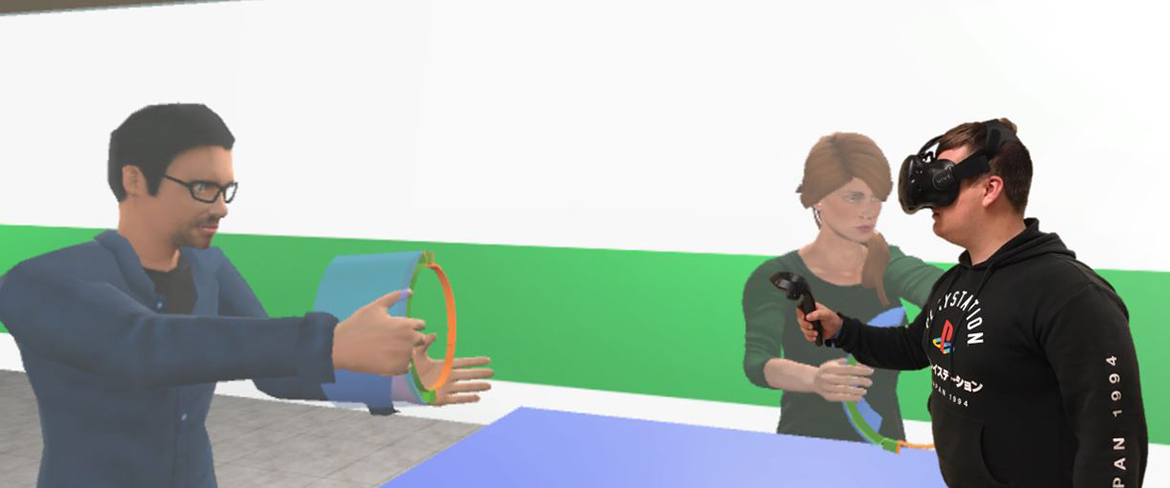The National Science Foundation (NSF) recently awarded OSU’s Department of Computer Science a Rapid Response Research (RAPID) grant of more than $100,000 to develop virtual reality-based training simulators for COVID-19 first responders. Computer science professor Dr. J. Cecil, who is leading the project, explained that the proposal was approved by NSF in a matter of weeks—a process that can typically take at least six months.
“The NSF moved on it faster because the country is facing an emergency,” Cecil said. “The federal agencies realize that engineers and scientists have to help the doctors."
Cecil himself is both an engineer and a scientist, with backgrounds in mechanical engineering, industrial engineering, and designing VR/augmented reality-based frameworks and simulators for domains such as deep-space exploration, manufacturing and healthcare. His team for this project, which consists of two undergraduates and one graduate student, will explore new research methods involving cyber-human principles to create virtual environments where medical professionals can be trained in proper wearing of personal protective equipment and collecting specimens from patients for COVID-19 testing.
“If these responders do not follow safe practices and procedures, patients or they themselves can get infected,” Cecil said. “Right now we have a decent number of trained nurses and physician assistants in the U.S., but some of them are getting infected with the virus. So we have to hire more first responders and we have to get them trained.”
Cecil went on to explain that the simulators can also be used to reinforce safety procedures for trained first responders, emphasizing the continued importance of the tasks.
Key advantages of VR-based training include eliminating risk to actual people during the learning process and providing immediate, simultaneous access to training for any number of first responders—all they need is a laptop or smartphone.
“We're going to be creating three kinds of environments,” Cecil explained. “Fully immersive simulators, where the nurses and first responders wear a 3D headset and use controllers to navigate and and virtually pick up objects with guidance from avatars; non-immersive, which can be run on anyone's laptop with a mouse and keyboard; and a third one, which is a recording of the various training steps, that will run on a smartphone.”
While hospitals and medical personnel may have to acquire the equipment to run the program (i.e. VR headset, laptops), the actual simulator software will be provided to them free of charge. Additionally, Cecil’s team will be providing free training on using the VR simulator through online workshops.
“This is a federal grant, so there are no profits involved,” Cecil said. “It is an opportunity for engineers, scientists and healthcare professionals to work together. This is for the social good. Very simply, that's what it is.”
The plan is to get the first version of the VR training simulator completed within three to four months. A similar non-RAPID project, Cecil said, would normally progress to this stage in seven to nine months. This accelerated schedule involves collaborating with emergency room staff and doctors at two Arizona-based hospitals, one of which Cecil and the department has worked with on a previous project.
“We design the environment with what we call cyber-human principles,” Cecil said. “For example, we have to design it so it's user-friendly and does not increase cognitive load on the users. Anyone can create a simulator, but it has to be cyber-human centric.”
Working with healthcare providers interactively—or in a “participatory design”—provides crucial feedback for Cecil and his team to achieve that balance of helpful complexity and user-friendly simplicity in their VR environments. And though the software may not be available for the first wave of COVID-19, Cecil said it’s important to be prepared for potential secondary waves or other health-related crises in the future.
“Our goal is to have it expand in terms of its functionalities and training capabilities,” Cecil said. “That's the benefit of creating a computer-based model in 3D. We can add detail, we can change or expand the simulator or training scope—it's very adaptable.”
Cecil said he hopes this opportunity to use VR to help COVID-19 first responders will act as a catalyst for future computer science and healthcare collaborations.
“Often we are so engrossed in what we do as computer scientists, engineers or medical professionals that it takes an outside influence to allow us to make a concerted effort in a new direction,” Cecil said. “In the healthcare industry, the trend toward using VR has been progressing in a positive manner over the past 10 to 15 years, but as far as we know, this will be the first VR environment used in the context of training nurses at the level we are discussing.”
This and other VR-based interdisciplinary projects at OSU—including space missions with grants from NASA, orthopedic surgery training and teaching STEM subjects to children with autism—have been possible thanks to Cecil and Dr. Blayne Mayfield co-founding the Center for Cyber-Physical Systems within the Department of Computer Science several years ago. And receiving grants from organizations such as the National Science Foundation gives due recognition to the talents and dedication of CS faculty and students, Cecil said.
“It also emphasizes the OSU theme of trying to help others,” Cecil added. “This is one way of coming together. For us to think more broadly or beyond what we normally do. To think about the nation and the world as a whole and see how we can help them. If any of us can help the doctors and the healthcare community, I think we should do that. Now is the time.”
Hospitals or healthcare professionals who are interested in participating in the COVID-19 first responder VR training project can email Dr. J. Cecil at j.cecil@okstate.edu.

